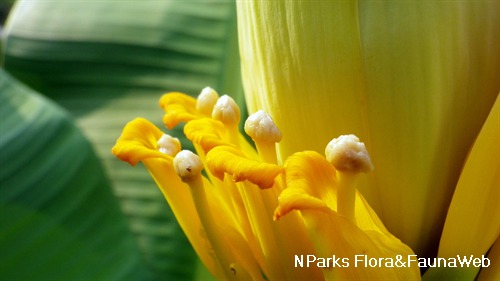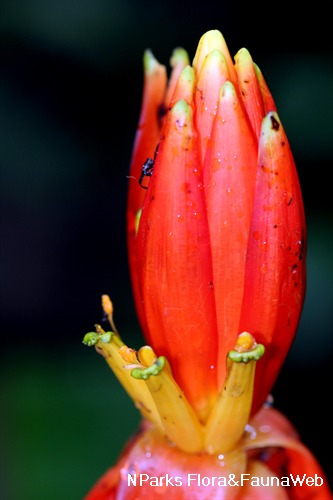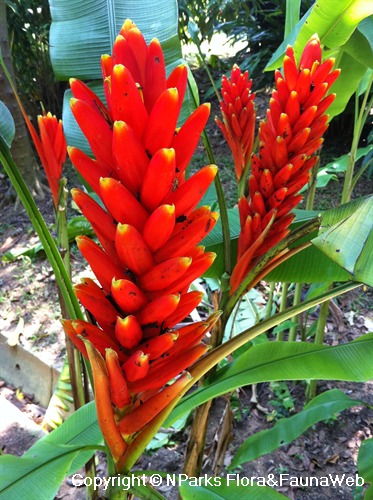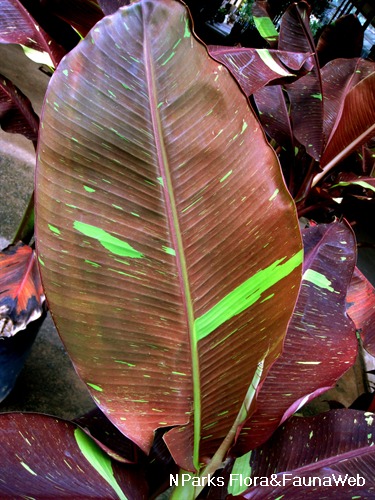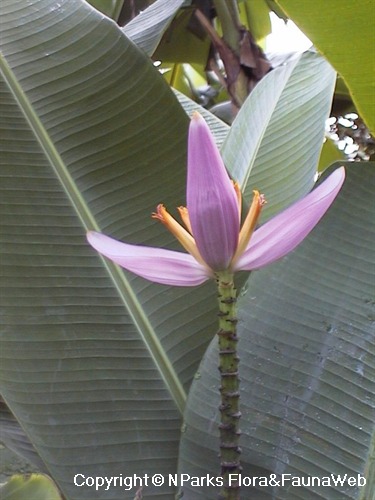
Name
Classifications and Characteristics
| Plant Division | Angiosperms (Flowering Seed Plants) (Monocotyledon) |
|---|---|
| Plant Growth Form | Herbaceous Plant |
| Lifespan (in Singapore) | Perennial |
| Mode of Nutrition | Autotrophic |
| Plant Shape | Umbrella |
| Maximum Height | 3 m |
Biogeography
| Native Distribution | Blangadesh & Myanmar |
|---|---|
| Native Habitat | Terrestrial (Secondary Rainforest) |
| Preferred Climate Zone | Tropical |
Description and Ethnobotany
| Others - Plant Morphology | Plants have green, slender pseudostems that grow up to 3 m in height that are first pale green and heavily waxy with black blotches near the upper portion. Leaves are medium dark green in colour with reddish midribs. Size of leaf can be up to 2 m long and 0.35 m wide and joined to petioles that can be as long as 0.6 m. Leaf shape is oblong with a truncated apex and base that is unequal-sided. Plant produces suckers freely that emerge close to the mother plant.Produces an erect inflorescence with pink bracts. Fruits are borne on a very compact bunch. Individual fruits can reach 10 cm long and can be purple or pink in colour when young, depending on the cultivar. Turn greenish yellow when ripe. Seeds are black.Used as a focal plant or for mass planting. Suitable for containers.Best grown under semi-shaded conditions, although plants can be adapted to grow under direct sunshine. Brighter light conditions will lead to shorter plants. Grow best if planted in fertile, well drained soil that is enriched with organic matter. Keep the roots moist and cool at all times by mulching with compost. Fertilise regularly to promote rapid and lush growth. Propagated by seeds, suckers or division. |
|---|
Landscaping Features
| Desirable Plant Features | Ornamental Flowers |
|---|---|
| Landscape Uses | General, Focal Plant, Container Planting |
Plant Care and Propagation
| Light Preference | Semi-Shade, Full Sun |
|---|---|
| Water Preference | Lots of Water |
| Plant Growth Rate | Moderate |
| Rootzone Tolerance | Fertile Loamy Soils, Well-Drained Soils |
| Maintenance Requirements | Moderate |
| Propagation Method | Seed, Sucker, Division |
Foliar
| Foliage Retention | Evergreen |
|---|---|
| Mature Foliage Colour(s) | Green |
| Mature Foliage Texture(s) | Smooth |
| Foliar Type | Simple / Unifoliate |
| Foliar Arrangement Along Stem | Rosulate / Rosette |
| Foliar Shape(s) | Non-Palm Foliage (Oblong) |
| Foliar Venation | Pinnate / Net |
| Foliar Margin | Entire |
| Foliar Apex - Tip | Truncate |
| Foliar Base | Oblique / Asymmetrical |
| Typical Foliar Area | Mesophyll ( 45cm2 - 182.25 cm2 ) |
| Leaf Area Index (LAI) for Green Plot Ratio | 3.5 (Shrub & Groundcover - Monocot) |
Non - Foliar and Storage
| Trunk Type (Non Palm) | Non Woody |
|---|---|
| Root Type | Underground (Fibrous Root) |
Floral (Angiosperm)
| Flower & Plant Sexuality | Unisexual Flowers , Monoecious |
| Flower Colour(s) | Purple |
|---|
| Inflorescence Type | Panicle |
| Flowering Habit | Monocarpic |
Fruit, Seed and Spore
| Mature Fruit Colour(s) | Green, Purple |
|---|---|
| Fruit Classification | Simple Fruit |
| Fruit Type | Fleshy Fruit , Berry |
Image Repository
Others
| Master ID | 951 |
|---|---|
| Species ID | 2245 |
| Flora Disclaimer | The information in this website has been compiled from reliable sources, such as reference works on medicinal plants. It is not a substitute for medical advice or treatment and NParks does not purport to provide any medical advice. Readers should always consult his/her physician before using or consuming a plant for medicinal purposes. |

